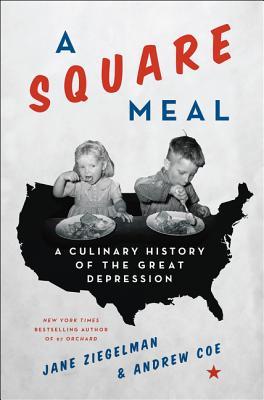
Today's post is on A Square Meal: A Culinary History of the Great Depression by Jane Ziegelman and Andrew Coe. It is 352 pages long and is published by Harper. The cover is white with two children eating and America behind them. The intended reader is someone who is interested in American history, food history, and where they intersect. There is no foul language, no sex, and no voilence in this book. There Be Spoilers Ahead.
From the back of the book- The decade-long Great Depression, a period of shifts in the country’s political and social landscape, forever changed the way America eats. Before 1929, America’s relationship with food was defined by abundance. But the collapse the economy, in both urban and rural America, left a quarter of all Americans out of work and undernourished—shattering long-held assumptions about the limitlessness of the national larder.
In 1933, as women struggled to feed their families, President Roosevelt reversed longstanding biases toward government sponsored “food charity.” For the first time in American history, the federal government assumed, for a while, responsibility for feeding its citizens. The effects were widespread. Championed by Eleanor Roosevelt, “home economists” who had long fought to bring science into the kitchen rose to national stature. Tapping into America’s longstanding ambivalence toward culinary enjoyment, they imposed their vision of a sturdy, utilitarian cuisine on the American dinner table.
Through the Bureau of Home Economics, these women led a sweeping campaign to instill dietary recommendations, the forerunners of today’s Dietary Guidelines for Americans. At the same time, rising food conglomerates introduced packaged and processed foods that gave rise to a new American cuisine based on speed and convenience. This movement toward a homogenized national cuisine sparked a revival of American regional cooking. In the ensuing decades, this tension between local traditions and culinary science have defined our national cuisine—a battle that continues today.
Review- An interesting read about how food changed over the beginning of the twentieth century. The book begins just before the turn of the century and goes to the beginning of the second World War. The authors talk about the way that rural and urban people ate and what the differences meant. The normal diet for rural people was over 4,000 calories per day and it was rich in all the good things that we need but the city dwellers were not so lucky and the poorer someone was the less good food they got. That sounds obvious but the details of how bad their diets were was shocking. What I found the most interesting was how much the Depression changed how Americans eat. Foods, like liver, were seen as less than before, so much so that the government had to convince the public to eat them because they were available and good for eating. My grandparents, who grew up during the Depression, loved all the foods that were discussed. At times the book does get a little off track at times but in general a very interesting and fast read.
I give this book Four out of Five stars. I was I given a copy of this book by Harper Collins in exchange for an honest review.
No comments:
Post a Comment